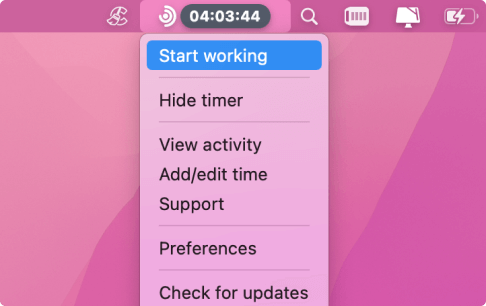
What Does WFH Stand For?
The WFH abbreviation stands for ‘Work from Home’. When someone identifies as a WFH employee, it means that they are working from their house or any place of residence outside the traditional office. In this article, we will explore the meaning of being a work from home employee, the difference between WFH and remote workers, and the benefits and downsides to working outside an office.
What Does WFH Mean?
Before, the term was used by people who had a home office and worked there at least once a week. Over the years, the WFH meaning has changed, and it has been adopted by self-employed individuals and freelancers who perform their duties in their private residence. To ensure a smooth transition to WFH, many organizations have implemented a home policy that outlines the technical requirements and guidelines for remote work. For this setup to be successful, the worker must meet the technical requirements laid down by their employer or client. For instance, they should have a reliable internet connection.
What Is the Importance of the WFH Concept Today?
Amidst the now historic health crisis, working from home has become essential in keeping businesses afloat. While many struggled to cope with the new setup, a lot of employees and companies found several benefits from remote work, which led to an increased demand in the WFH concept. Flexible working hours allow workers to manage their schedules better, leading to reduced stress and increased productivity. People can perform their duties while quickly switching between personal work or taking care of their families. Also, for those who face health issues, working from home has become a great option to contribute to their family’s well-being. However, establishing clear boundaries between work and personal life is crucial to prevent burnout and maintain productivity. Despite the convenience of remote work, employees should create boundaries to separate their professional and personal responsibilities effectively.
Although working from home offers unparalleled flexibility and many other advantages, it still comes with unique challenges. For instance, the risks of data breaches and leaks are amplified when employees use company-issued devices in an at-home setting. As a result, companies had to make significant strides and invest in proper equipment and technology. After all, without the right tools, managing WFH employees can be challenging, if not downright impossible. File sharing tools like Google Drive and Dropbox have become essential for seamless collaboration and document access among remote teams.
When a company adopts a WFH model, it must implement new software that will aid in successful business operations. With no face-to-face contact, managers often struggle to ensure that employees are actually working during office hours. After all, there are more distractions at home than in an office setting: anything from the television sitting enticingly in the living room to an unfinished chore begging to be done. Thankfully, there are plenty of digital tools that will ensure your employees’ productivity.
The flip side to this challenge comes in the form of employees being able to create their own schedules and work environments. The freedom to design their own workspaces and schedules undeniably enhances employee productivity and work-life balance. A well-structured home office can lead to increased focus and better engagement. At the same time, minimizing distractions by creating a structured work environment helps employees stay focused on their tasks. Using project management tools like Asana or Monday helps in tracking and managing projects effectively, while time tracking tools like Traqq ensures that every minute spent working is accounted for.
Incidentally, the employee time tracker app, Traqq, works both offline and online, making time tracking convenient for your work-from-home employees. Once they start the timer, it will run automatically and discreetly in the background. It also monitors the apps that they use and the websites they visit. Traqq even lists the amount of time that a user spends on certain apps and websites. This way, managers can ensure that their WFH staff are doing productive work.

Are WFH Jobs Same as Remote Work?
Working from home and remote work have similarities and differences. Remote work allows employees to work from different locations, providing flexibility and access to a global talent pool. Employees can choose to work from various locations such as coffee shops or co-working spaces. However, managing a distributed workforce across different time zones can present coordination challenges. If we’re going to strictly define WFH, we need to stick with individuals who perform their duties in their private residence.
Conversely, someone who works remotely can complete their tasks from anywhere they want. For example, they can work from home for two days, then move to a co-working space for the rest of the week. Basically, the meaning of remote work lies in the fact that the employee can work anywhere they want while someone who works from home, well, is limited to a single place.
Working from Home
For people with caregiving responsibilities, WFH means they will still be able to participate in the workforce. They can care for their sick, elderly, or young loved ones while performing their duties at work. However, an employee must remember that caretaking and having a career is a difficult balance to maintain. While it is undeniable that WFH is beneficial for people with lots of domestic responsibilities, it is not a magic pill.
Remote Work
Work-from-home opportunities let employees perform their tasks in their pajamas. On the other hand, working remotely can give a semblance of going to a traditional workplace. Employees can travel from their home to whatever location they choose to work from, such as a café or a co-working space. Even so, remote work offers more flexibility than a traditional 9-5 job as it usually allows workers to choose their work hours. Moreover, they can take their work to the beach, the mountains, or anywhere they want, so long as they stay connected to the internet and can even have some fun along the way.
Getting out of the house is a critical part of remote work. Being at home allows an individual to jump between their caretaking responsibilities and their paid work. However, in cases where employees need zero domestic distractions to get work done, they would head to a dedicated co-working space. This also creates a great opportunity to network with other remote workers. Moreover, gives them the face-to-face contact that they would miss when working from home.
Benefits of Working from Home
Working from home offers numerous benefits for both employees and employers. One of the most significant advantages is the ability to achieve a better work-life balance. With the flexibility to create their own schedule, remote employees have more freedom in balancing their job responsibilities with their personal life. This, in turn, can lead to increased happiness and satisfaction with their work-life balance, should they successfully attain it. Additionally, working from home can result in cost savings for both employees and employers, as it eliminates the need for commuting and reduces the requirement for office space. Many companies have found that allowing employees to work from home can also lead to increased productivity, as employees are able to work in a comfortable and distraction-free environment.
Collaboration and Communication
Effective collaboration and communication are essential parts of successful remote work. Access to instant messaging tools, such as Microsoft Teams, and video conferencing platforms, such as Zoom, can help remote teams stay connected, facilitate communication, and help share ideas with colleagues. Regular virtual meetings can also help to maintain a sense of company culture and ensure that all team members are on the same page. By providing employees with the necessary tools and technologies, organizations can ensure that remote employees are able to collaborate and communicate effectively, regardless of their location.
Security and Data Protection
When working remotely, network security and data protection are of utmost importance. Organizations must ensure that remote employees have access to reliable technology and secure networks to prevent data breaches and cyber attacks. Multi-factor authentication and encryption can help to protect sensitive data, and regular security updates and training can help to prevent vulnerabilities.
Additionally, organizations should establish clear policies and procedures for work outside the office, including guidelines for data protection and network security. By prioritizing security and data protection, organizations can minimize the risks associated with remote work and ensure that their data and systems are protected.
Tools and Technologies
There are many tools and technologies available to support remote work, including video conferencing platforms, instant messaging tools, and project management software. Google Drive and other cloud storage platforms can also help teams to share files and collaborate on documents, and a PDF editor can help with additional tasks like annotating, signing, and filling forms. Additionally, time management and productivity tools, such as Traqq, can help remote employees to stay focused and on track. By providing employees with the right tools and technologies, organizations can help to maintain productivity and facilitate collaboration, regardless of location. Many organizations also use messaging tools, such as Slack and Microsoft Teams, to stay connected and communicate with remote teams.
How to Ensure Work-from-Home Success
By looking at how companies scrambled to maintain their operations during the pandemic, we can say that some were more prepared than others. However, for a work-from-home setup to be successful, managers must clearly define expectations. Moreover, they should ensure constant communication. Implementing a comprehensive work from home policy can help organizations optimize work-life balance and ensure operational efficiency. Moving to remote operations can be a large undertaking, and it involves a whole new set of responsibilities. It includes auditing the company, training staff, and updating IT infrastructure. Here are some steps that an organization can follow when transitioning employees to a work from home environment:
Step 1: Create a Plan to Identify Necessary Competencies and Critical Tasks
Instead of focusing on existing roles, you should identify necessary competencies and critical tasks. Think about key responsibilities and tasks that have to move to remote operations. For instance, if you’re working with a marketing analyst, their task would involve gathering and evaluating data, designing market surveys, and assessing marketing channels.
Step 2: Anticipate Future Needs and Problems
When identifying your current competencies, you should also determine where you have gaps. Even when you’re transitioning to a permanent work from home setup, you should not settle for mediocrity. So, determine how you can keep on improving by using objective performance metrics, appraisal data, and client feedback. Once you discover the missing competencies, you can start considering the roles that can be sourced within operations. In the process, you will also discover jobs that must be open to candidates seeking remote work. This way, you will attract highly competitive talent.
Step 3: Evaluate the Costs and Benefits
After performing the analysis from Step 2, you will now compare the estimated costs of on-site and remote labor. Don’t forget to consider the reduced real-estate expenses when doing your calculations. When moving to a permanent WFH setup, you will look at real estate in a different way. After all, the money that goes into maintaining an office space is money not spent on technology, people, and customer relationship. Offering flexible work arrangements can significantly influence the decision of top talent to join or stay with a company. Even so, remember that remote work also has unique expenditures, including specialized tech, occasional team building events and in-person meetings.
Step 4: Restructure Roles as Long-Term WFH Positions
While many jobs can be done from home, not all of them are optimized for a remote setup. When operating virtually, you can expect to have delays in communication. After all, there wouldn’t be spontaneous, face-to-face communication. You can no longer walk by someone’s desk to ask questions or request updates. Without the paralinguistic and non-verbal cues employees get from personally talking to colleagues, they’re missing socioemotional undertones that make collaborating easy.
To mitigate communication issues, map out formal organizational processes and hierarchies. Every employee must know who they report to. Moreover, you should encourage frequent yet short video calls. By having more social contact points, you can improve collaboration between geographically scattered team members.
Creating a Productive Environment
Creating a productive environment is essential for successful remote work. This can involve setting up a designated workspace, free from distractions, and establishing a routine and schedule. Minimizing distractions, such as turning off notifications and finding a quiet space, can also help remote employees to stay focused. Additionally, taking regular breaks and prioritizing self-care can help to prevent burnout and maintain productivity.
By setting up a productive environment, WFH employees can stay motivated and focused, and achieve a better work-life balance. Many companies are also providing training and support to help WFH employees create a productive environment and maintain their mental health while working remotely.
In Conclusion
When moving to a permanent work-from-home setup, a shift in company culture must take place. This model will only succeed when management trusts their employees. Indeed, open communication is critical for managers and employees.

